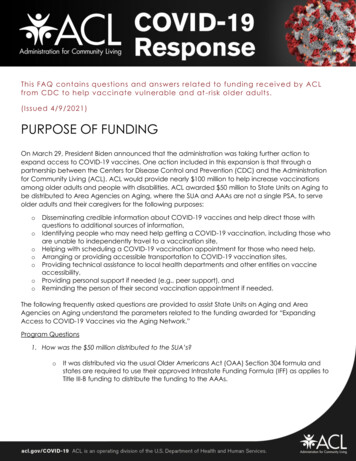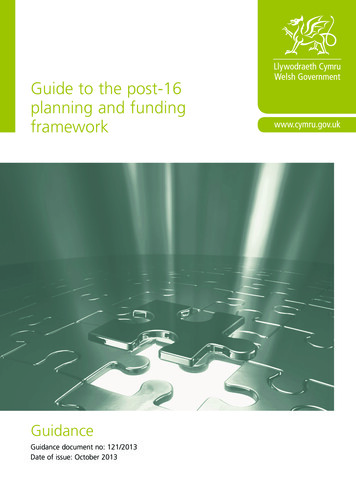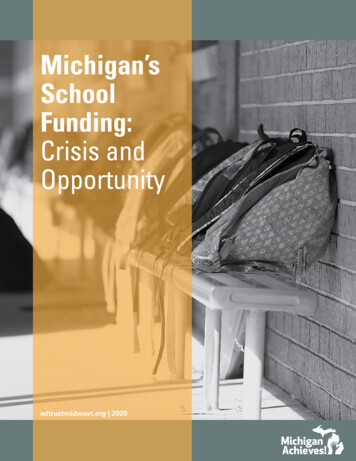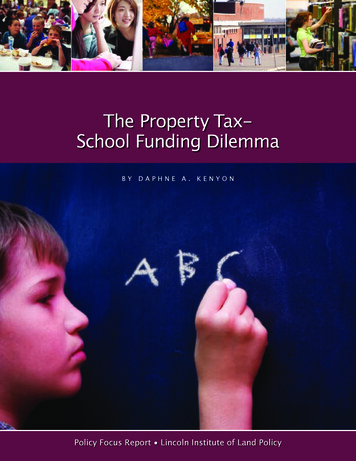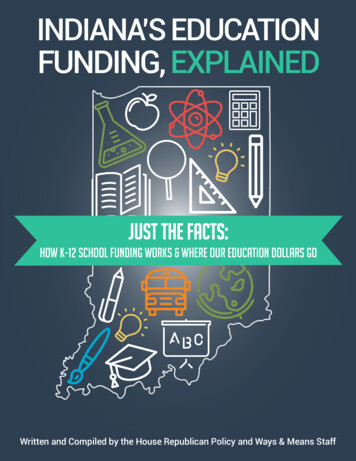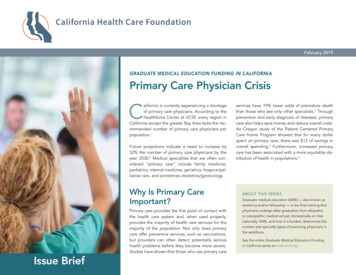
Transcription
February 2019GRADUATE MEDICAL EDUCATION FUNDING IN CALIFORNIAPrimary Care Physician CrisisCalifornia is currently experiencing a shortageof primary care physicians. According to theHealthforce Center at UCSF, every region inCalifornia except the greater Bay Area lacks the recommended number of primary care physicians perpopulation.1Future projections indicate a need to increase by32% the number of primary care physicians by theyear 2030.2 Medical specialties that are often considered “primary care” include family medicine,pediatrics, internal medicine, geriatrics, hospice/palliative care, and sometimes obstetrics/gynecology.Why Is Primary CareImportant?Issue BriefPrimary care provides the first point of contact withthe health care system and, when used properly,provides the majority of health care services for themajority of the population. Not only does primarycare offer preventive services, such as vaccinations,but providers can often detect potentially serioushealth problems before they become more severe.Studies have shown that those who use primary careservices have 19% lower odds of premature deaththan those who see only other specialists.3 Throughprevention and early diagnosis of diseases, primarycare also helps save money and reduce overall costs.An Oregon study of the Patient Centered PrimaryCare Home Program showed that for every dollarspent on primary care, there was 13 of savings inoverall spending.4 Furthermore, increased primarycare has been associated with a more equitable distribution of health in populations.5ABOUT THIS SERIESGraduate medical education (GME) — also known asresidency and/or fellowship — is the final training thatphysicians undergo after graduation from allopathicor osteopathic medical school, domestically or internationally. GME, and how it is funded, determines thenumber and specialty types of practicing physicians inthe workforce.See the entire Graduate Medical Education Fundingin California series at www.chcf.org.
Figure 2. G ME Graduates Pursuing Primary Care,California, 1997–2012Training California’sPrimary Care PhysiciansThere are many reasons for California’s primarycare physician crisis.6 One important factor relatesto graduate medical education (GME). Between1997 and 2012, the total number of GME graduatesin California increased by 8.1%, while California’spopulation increased by 17%.7 Furthermore, whilethe number of non-primary care residents and fellows graduating from California GME programsincreased, the number of primary care graduatesdeclined over this same period (see Figure 1).The percentage of graduates in primary care (outof total GME graduates in California) declined from29.7% to 23.3% over this same period (Figure 2).8Figure 1. N on-Primary and Primary Care Residents/Fellows Graduating from Sponsoring California Institutions,1997–2012PERCENTAGE OF GME 8.7%200228.4%27.4%2003Non-Primary CareNUMBER OF RESIDENTS/FELLOWSPrimary 01022.3%201122.0%2012199726.0%200523.3%2012FIGURES 1 AND 2:Notes: Primary care residencies include pediatrics, family medicine, and internal medicine. Corrected for further non-primary care specialized residents.Source: American Medical Association (AMA) Masterfile Historical Residency File, 2017.California Health Care Foundation2
Who trains primary care physicians? In 2015, 36.9%of all primary care GME graduates in California graduated from a University of California (UC) residencyor fellowship program. Different UC campuses focuson primary care to differing degrees. For example,21.8% of UCSF graduates specialize in primary carefields, compared with 15.9% of UCLA and UC SanDiego graduates. Table 1 lists the California sponsoring institutions that produce the most primary caregraduates, and the percentage of their total graduates that specialize in primary care.Table 1. P rimary Care Graduates as a Percentage of GME Graduates in the California Sponsoring InstitutionsThat Produce the Most Primary Care Graduates, 2015PRIMARY CARE GRADUATESNUMBER OFGME GRADUATESNUMBER% OF GMEUCSF51311221.8%UCLA5048015.9%University of Southern California3486919.8%Kaiser Permanente – Southern California1155648.7%Loma Linda University Medical Center1845328.8%UC Davis2204420.0%UC San Diego2514015.9%Kaiser Permanente Medical Group843845.2%UC Irvine2233716.6%Contra Costa Regional Medical Center3434100.0%Cedars-Sinai Medical Center1462517.1%Ventura County Medical Center1616100.0%Santa Clara Valley Medical Center511631.4%Alameda County Medical Center411434.2%San Joaquin General Hospital181372.2%Kern Medical371335.1%SPONSORING INSTITUTIONIncreasing the Number ofPrimary Care GraduatesCalifornia does not have a central governing bodythat is responsible for physician workforce planning.Instead, GME is subsidized by a number of federaland state agencies, with little to no coordination,transparency, or accountability. Because individualGME sponsoring institutions in California make decisions about how many physicians get trained in eachspecialty, incentives need to be created to encouragegrowth of primary care. Because primary care GMEprograms do not generate revenues for sponsoringinstitutions comparable to other procedure-basedspecialties, supplemental funding through federaland state subsidies may be necessary.Funding the expansion of primary care GMEcapacity. There are two main avenues for expanding GME capacity in primary care. The first avenueis through the expansion of GME programs at existing sponsoring institutions to train more residentsand fellows. Unfortunately, Medicare (the largestfunder of GME training) does not allow expansionof existing GME programs, so subsidies would needto come from other sources such as the VeteransHealth Administration, the Health Resources andServices Administration, Medi-Cal, California’s SongBrown program, California’s Proposition 56 funding,or the University of California or some other healthcare institution’s budget.The second avenue is through the creation of newprimary care GME programs in hospitals, health systems, and community clinics with sufficient interestand expertise in medical education. New teachingGraduate Medical Education Funding in California Primary Care Physician Crisis3
hospitals are eligible for and could receive MedicareGME funding once program accreditation is receivedand training begins. Although new hospital-basedprograms could potentially pay for training usingMedicare GME funds, there are significant start-upcosts in the first few years of any program that wouldnot be covered by Medicare.If We Build It,Will They Come?Currently, there are more residency positions inCalifornia than doctors graduating from Californiamedical schools, with 1,133 California medicalschool graduates and 2,617 first-year residency positions available in 2017.9 Of those graduates, 68.2%remained in California for their GME programs, thehighest retention rate of any state. The remainingresidency positions tend not to have problems filling(96.75% of all positions filled in 2018), and primarycare is no exception, with 97.8% of primary carepositions filling. Positions are usually unfilled for temporary, situational reasons and not because of lack ofinterest. Family medicine residencies within the stateare overwhelmed with applications each year — insome cases receiving several hundred applicationsfor a single residency position. Of all GME graduates,70.4% remained in California to practice medicine,also the highest retention rate of any state.California Health Care FoundationSome of the applicants are graduates of medicalschools outside the US who need to complete aresidency in the US to obtain a California medicallicense. Nationally, 30% of family medicine residencypositions each year are filled with international medical graduates (IMGs), partially because of decliningUS medical student interest in primary care specialties.10 However, in California in 2018 only 22.6% offamily medicine residencies were filled by IMGs, themajority of whom were US citizens who had attendedinternational medical schools (17.9% US-born IMGscompared with 4.7% foreign IMGs).11 With the hugecompetition for each residency position, there is littleindication that an increase in the number of primarycare GME positions would go unfilled.The AuthorsThis paper was authored by Diane Rittenhouse, MD,MPH, Alexandra Ament, and Kevin Grumbach, MD,of the University of California, San Francisco, andStephen Petterson, PhD, Zachary Levin, and AndrewBazemore, MD, MPH, of the Robert Graham Center.About the FoundationThe California Health Care Foundation is dedicatedto advancing meaningful, measurable improvementsin the way the health care delivery system providescare to the people of California, particularly thosewith low incomes and those whose needs are notwell served by the status quo. We work to ensurethat people have access to the care they need, whenthey need it, at a price they can afford.CHCF informs policymakers and industry leaders,invests in ideas and innovations, and connects withchangemakers to create a more responsive, patientcentered health care system.For more information, visit www.chcf.org.4
Endnotes1. Janet Coffman, Igor Geyn, and Kristine Himmerick,California’s Primary Care Workforce: Current Supply,Characteristics, and Pipeline of Trainees, HealthforceCenter at UCSF, February 16, 2017,healthforce.ucsf.edu (PDF).2. California: Projecting Primary Care Physician Workforce,Robert Graham Center, accessed December 7, 2018,www.graham-center.org (PDF).3. Jack Ende, Strengthening the Primary Care Workforce,National Coalition on Health Care, September 20, 2017,nchc.org (PDF).4. Sherril Gelmon et al., Implementation of Oregon’sPCPCH Program: Exemplary Practice and ProgramFindings, Oregon Health Authority, September 2016,www.oregon.gov (PDF).5. Barbara Starfield, Leiyu Shi, and James Macinko,“Contribution of Primary Care to Health Systemsand Health,” The Milbank Quarterly 83, no. 3(September 2005): 457– 502, www.ncbi.nlm.nih.gov.6. See Coffman, Geyn, and Himmerick, California’s PrimaryCare Workforce, healthforce.ucsf.edu.7. US Census Bureau and 2017 AMA Masterfile HistoricalResidency File.8. 2017 AMA Masterfile Historical Residency File.9. Association of American Medical Colleges (AAMC)data tables: www.aamc.org (PDF); and NationalResident Matching Program (NRMP) data tables:kinstacdn.com (PDF).10. “2018 Match Results for Family Medicine,”American Academy of Family Physicians, accessedDecember 7, 2018, www.aafp.org.11. AAMC data tables and NRMP data tables.Graduate Medical Education Funding in California Primary Care Physician Crisis5
and expertise in medical education. New teaching Table 1. Primary Care Graduates as a Percentage of GME Graduates in the California Sponsoring Institutions That Produce the Most Primary Care Graduates, 2015 SPONSORING INSTITUTION NUMBER OF GME GRADUATES PRIMARY CARE GRADUATES NUMBER % OF GME UCSF 513 112 21.8% UCLA 504 80 15.9%



